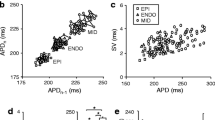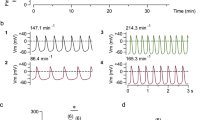Summary
Membrane currents were measured in single sino-atrial node cells of guinea pig and rabbit hearts as well as in guinea pig ventricular myocytes using the patch-clamp technique. UL-FS 49 blocked the L-type calcium current (ICa) in sino-atrial node cells at drug concentrations wich had little or no effect on the amplitude of the hyperpolarization-activated current ih(f). In guinea pig ventricular myocytes UL-FS 49 also blocked ICa but not as strongly as in sino-atrial node cells. In a computer simulation of the sino-atrial node action potential the extent of rate reduction by block of either ih(f) or ICa was estimated. From the data obtained by single cell measurements and the computations we concluded that rate reduction in primary pacemaker cells by application of UL-FS 49 is mainly due to a use dependent block of the L-type calcium current. Voltage dependent unblock of iCa at potentials more negative than −50 mV together with the lower drug sensitivity of ventricular cells can explain the “specific bradycardic action” of UL-FS 49.
Similar content being viewed by others
References
Bleeker WK, Mackaay AJC, Masson-Pevet M, Bouman LN, Becker AE (1980) Functional and morphological organization of the rabbit sinus node. Circ Res 46:11–22
Boumann LN, Jongsma HJ Opthof T, Van Ginneken ACG (1985) Does if contribute to pace-making in the rabbit sinoatrial node? J Physiol (Lond) 358:51P
Brown HF (1982) Electrophysiology of the sinoatrial node. Physiol Rev 62:505–530
Dennis PD, Vaughan Williams EM (1986) Further studies of alinidine induced bradycardia in the presence of caesium. Cardiovasc Res 20:375–378
DiFrancesco D (1981) A new interpretation of the pace-maker current in calf Purkinje fibres. J Physiol (Lond) 314:359–376
DiFrancesco D (1985) The cardiac hyperpolarizing-activated current, if, origins and developements. Prog Biophys Mol Biol 46:163–183
DiFrancesco D (1986) Characterization of single pacemaker channels in cardiac sino-atrial node cells. Nature 324:470–473
DiFrancesco D (1987) The pacemaker current in the sinus node. Eur Heart 18:19 -23
DiFrancesco D, Ferroni A, Mazzanti M, Trombe C (1986) Properties of the hyperpolarizing-activated current (if) in cells isolated from the rabbit sino-atrial node. J Physiol (Lond) 377:61–88
Doerr T, Denger R, Trautwein W (1988) Quantitative analyses of the L-type calcium current during the action potential in single sino-atrial node cells of the rabbit heart. Pflügers Arch 412 [Suppl 1]:R 23
Doerr T, Denger R, Trautwein W (1989) Calcium currents in single SA nodal cells of the rabbit heart studied with action potential clamp. Pflügers Arch 413:599–603
Franke H, Su CAPF, Schumacher K, Seiberling M (1987) Clinical pharmacology of two specific bradycardiac agents. Eur Heart J 8:91–98
Gilmour RF Jr, Zipes DP (1983) Basic electrophysiology of the slow inward current. In: Stone PH, Amman EM (eds) Calcium channel blocking agents in the treatment of cardiovascular disorders. Futura, Mount Kisco, New York, pp 1–37
Guth BD, Heusch G, Seitelberger R, Matsuzaki M, Ross J (1987) Role of heart rate reduction in the treatment of exercise-induced myocardial ischaemia. Eur Heart J 8: 61–68
Hagiwara N, Irisawa H, KameyamaM (1987) Transient-type calcium current contributes to the pace-maker potential in isolated sino-atrial node. J Physiol (Lond) 382:104P
Hagiwara N, Irisawa H, Kameyama M (1988) Contribution of two types of calcium currents to the pacemaker potentials of rabbit sino-atrial node cells. J Physiol 395:233–253
Hamill OP, Marty A, Neher E, Sakmann B, Sigworth FJ (1981) Improved patch-clamp techniques for high-resolution current recording from cells and cell-free membrane patches. Pflügers Arch 391:85–100
Harron DWG, Shanks RG (1985) Pharmacology, clinical pharmacology and potential therapeutic uses of the specific bradycardic agent alinidine. Eur Heart J 6:722–729
Hohnloser S, Weirich J, Homburger H, Antoni H (1982) Electrophysiological studies on effects of AQ-A 39 in the isolated guinea pig heart and myocardial preparations. Arzneimittelforschung 32 (11):730–734
Irisawa H (1978) Comparative physiology of the cardiac pacemaker mechanism. Physiol Rev 58:461–498
Irisawa H, Noma A (1982) Pacemaker mechanisms of rabbit sinoatrial node cells. In: Bouman LN, Jongsma III (eds) Cardiac rate and rhythm. Martinus Nijhoff, The Hague, pp 35–51
Irisawa H, Noma A (1984) Pacemaker currents in mammalian nodal cells. J Mol Cell Cardiol 16:777–781
Irisawa H, Yanagihara K (1980) The slow inward current of the rabbit sino-atrial nodal cells. In: Zipes DP, Bailey JC, Elharrar V (eds) The slow inward current and cardiac arrhythmias. Martinus Nijhoff, The Hague, pp 265–284
Kobinger W (1985) Specific bradycardic agents, a new approach to therapy in angina pectoris? Prog Pharmacol 5/4:89–100
Kobinger W (1989) Specific bradycardiac agents. In: Vaughan Williams EM (ed) Antiarrhythmic drugs. Springer, Berlin Heidelberg New York, pp 423–452 (Handbook of experimental pharmacology, vol 89)
Kobinger W, Lillie C (1984) Cardiovascular characterization of UL-FS 49,1,3,4,5-tetrahydro-7,8-dimethoxy-3-[3-[[2-(3,4-dimethoxyphenyl)ethyl]methylimino]-propyl]-2H-benzazepin-2-on hydrochloride, a new “specific bradycardic agent”. Eur J Pharmacol 104:9–18
Kobinger W, Lillie C (1987) Specific bradycardic agents — a novel pharmacological class? Eur Heart J 8 [Suppl L]:7–15
Kobinger W, Lillie C (1988) Falipamil (AQ-A 39) and UL-FS 49. Cardiovasc Drug Rev 6:35–53
Kokubun S, Nishimura M, Noma A, Irisawa H (1980) The spontaneous action potential of rabbit atrioventricular node cells. Jpn J Physiol 30:529–540
Kokubun S, Nishimura M, Noma A, Irisawa H (1982) Membrane currents in the rabbit atrioventricular node cell. Pfliigers Arch 393:15–22
Kreitner D (1985) Electrophysiological study of the two main pacemaker mechanisms in the rabbit sinus node. Cardiovasc Res 19:304–318
Krumpl G, Schneider W, Raberger G (1986) Can exercise-induced regional contractile dysfunction be prevented by selective bradycardiac agents? Naunyn-Schmiedeberg's Arch Pharmacol 334:540–543
Lillie C, Kobinger W (1983) Comparison of the bradycardic effects of alinidine (St 567), AQ-A 39 and verapamil on guinea-pig sinoatrial node superfused with different Ca2+ and NaCl solutions. Eur J Pharmacol 87:25–33
Lillie C, Kobinger W (1984) Decrease in bradycardic effect of AQ-A 39 and alinidine in guinea-pig sinoatrial node depolarized by high external K+-concentration. Naunyn-Schmiedeberg's Arch Pharmacol 328:210–213
Lillie C, Kobinger W (1987) Investigations differentiating the mechanism of specific bradycardic agents from that of calcium channel blockers. Naunyn-Schmiedeberg's Arch Pharmacol 335: 331–333
Maylie J, Morad M (1981) Ionic characterization of pacemaker current in voltage clamped rabbit SA node. Biophys J 33:11a
Miyamoto J, Kotake H, Mashiba H (1986) Study on bradycardic induced by diltiazem in the rabbit sinoatrial node. Arzneimittelforschung 36:808–810
Nakayama T, Kurachi Y, Noma A, Irisawa H (1984) Action potential and membrane currents of single pacemaker cells of the rabbit heart. Pflügers Arch 402:248–257
Noble D (1984) The surprising heart: a review of recent progress in cardiac electrophysiology. J Physiol 353:1–50
Noma A, Irisawa H (1974) The effect of sodium ion on the initial phase of sinoatrial pacemaker action potentials in rabbits. Jpn J Physiol 24:617–632
Noma A, Irisawa H, Kokobun S, Kotake H, Nishimura M, Watanabe Y (1980) Slow current systems in the A — V node of the rabbit heart. Nature 285:228–229
Noma A, Morad M, Irisawa H (1983) Does the “pacemaker current” generate the diastolic depolarization in the rabbit SA node cells? Pfliigers Arch 397:190–194
Osterrieder W, Pelzer D, Yang QF, Trautwein W (1981) The electrophysiological basis of the bradycardic action of AQA 39 on the sinoatrial node. Naunyn-Schmiedeberg's Arch Pharmacol 317:233–237
Pelzer D, Trautwein W, McDonald TIT (1982) Calcium channel block and recovery from block in mammalian ventricular muscle treated with organic channel inhibitors. Pflügers Arch 394:97–105
Senges J, Rizos I, Brachmann J, Anders G, Jauernig R, Hamman HD, Kübler W (1983) Effect of nifedipine and AQ-A 39 on the sinoatrial and atrioventricular nodes of the rabbit and their antiarrhythmic action on atrioventricular nodal reentrant tachycardia. Cardiovasc Res 17:132–144
Seyama I (1976) Characteristic of the rectifying properties of the sino-atrial node cell of the rabbit. J Physiol 255:379–397
Snyders DJ, van Bogaert PP (1987) Alinidine modifies the pace-maker current in sheep Purkinje fibers. Pflügers Arch 410:83–91
Taniguchi J, Kokubun S, Noma A, Irisawa H (1981) Spontaneously active cells isolated from the sino-atrial and atrio-ventricular nodes of the rabbit heart. Jpn J Physiol 31:547–558
Trautwein W, Pelzer D, McDonald TF, Osterrieder W (1981) AQ-A 39, a new bradycardic agent which blocks myocardial calcium (Ca) channels in a frequency- and voltage-dependent manner. Naunyn-Schmiedeberg's Arch Pharmacol 317:228–232
Trautwein W, Pelzer D, McDonald TF (1983) Interval-and voltage-dependent effects of the calcium channel-blocking agents D600 and AQA 39 on mammalian ventricular muscle. Circ Res 52 [Suppl 1]:60–68
van Bogaert PP, Goethals M (1987) Pharmacological influence of specific bradycardic agents on the pacemaker current on sheep cardiac Purkinje fibres. A comparison between three different molecules. Eur Heart J 8:35–42
van Ginneken ACG, Bouman LN, Jongsma HJ, Duivenvoorden JJ, Opthof T, Giles WR (1987) Alinidine as a model of the mode of action of specific bradycardic agents on SA node activity. Eur Heart J 8:25–33
Vaughan Williams EM (1987) Antiarrhythmic action of specific bradycardic agents. Eur Heart J 8:17–18
West TC (1955) Ultramicroelectrode recording from the cardiac pacemaker. J Pharmacol Exp Ther 115:283–290
West TC (1972) Electrophysiology of the sinoatrial node. In: De Mello WC (ed) Electrical phenomena in the heart. Academic, New York, pp 191–217
Yanagihara K, Irisawa H (1980) Inward current activated during hyperpolarization in the rabbit sinoatrial node cell. Pfliigers Arch 385:11–19
Yanagihara K, Noma A, Irisawa H (1980) Reconstruction of the sino-atrial node pacemaker potential based on voltage clamp experiments. Jpn J Physiol 30:841–857
Author information
Authors and Affiliations
Additional information
Send offprint requests to W. Trautwein at the above address
Rights and permissions
About this article
Cite this article
Doerr, T., Trautwein, W. On the mechanism of the “specific bradycardic action” of the verapamil derivative UL-FS 49. Naunyn-Schmiedeberg's Arch Pharmacol 341, 331–340 (1990). https://doi.org/10.1007/BF00180659
Received:
Accepted:
Issue Date:
DOI: https://doi.org/10.1007/BF00180659




